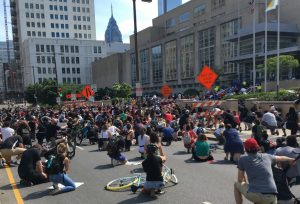
In an example of relational power in Philadelphia, teachers at Central High School protest against anti-Black racism. Image credit: Philadelphia Public School Network
My case study will examine an organization that operates as a combination of parent/community member and student organizing. In a city with a burgeoning—and highly controversial—mainstream education reform industry, Bernard Loomer’s discussion of power in Sara Mcalister and Keith C. Catone’s article, “Real Parent Power: Relational Organizing for Sustainable School Reform,” is quite applicable to describe the dynamic between reformer and organizer. Mcalister and Catone write that Loomer theorized that there were two conceptions of power: unilateral (power over) and relational (power with) (Mcalister and Catone, 2013, p. 27). Mainstream corporate reformers tend to try to amass unilateral power, which “values the ability to exercise influence over others,” while grassroots parent and community organizations are more likely to try to enact relational power, which is generative and assumes that “through mutual relationships parties can increase each other’s power without it coming at anyone else’s expense” (Mcalister and Catone, 2013, p. 27).
In terms of youth organizing, Ben Kirshner’s article, “Guided Participation in Youth Activism,” succinctly sums up three different models of youth organizing that he encountered during his research: facilitation, apprenticeship, and joint work (2008). Kirshner describes facilitation as when “adults sought to be neutral facilitators of a youth-led process,” providing resources and support with structuring the composition and schedules of different groups, but essentially allowing youth to come up with and execute organizing projects on their own (Kirshner, 2008, p. 75). Apprenticeship involves more adult participation and as youth-centered as facilitation; under this model, adults take on greater decision-making and working roles in a particular campaign or organization, but they focus on making it an intentional learning experience for students (Kirshner, 2008, p. 74). Joint work also involves a great deal of adult participation, but it is less youth-centered than apprenticeship or facilitation, with students more or less expected to step up and act like adult organizers in order to work as equal members of a team.
